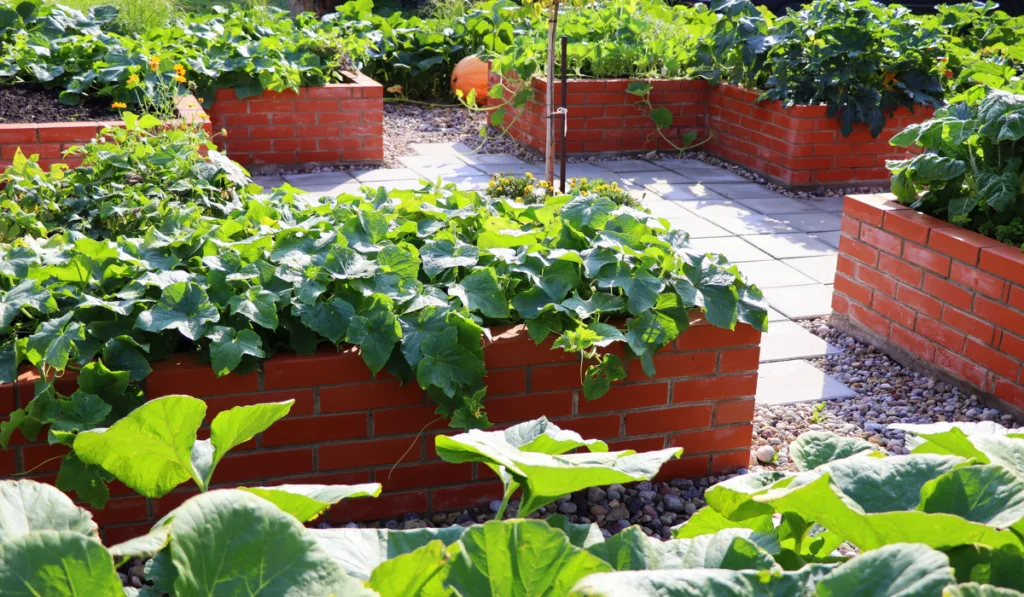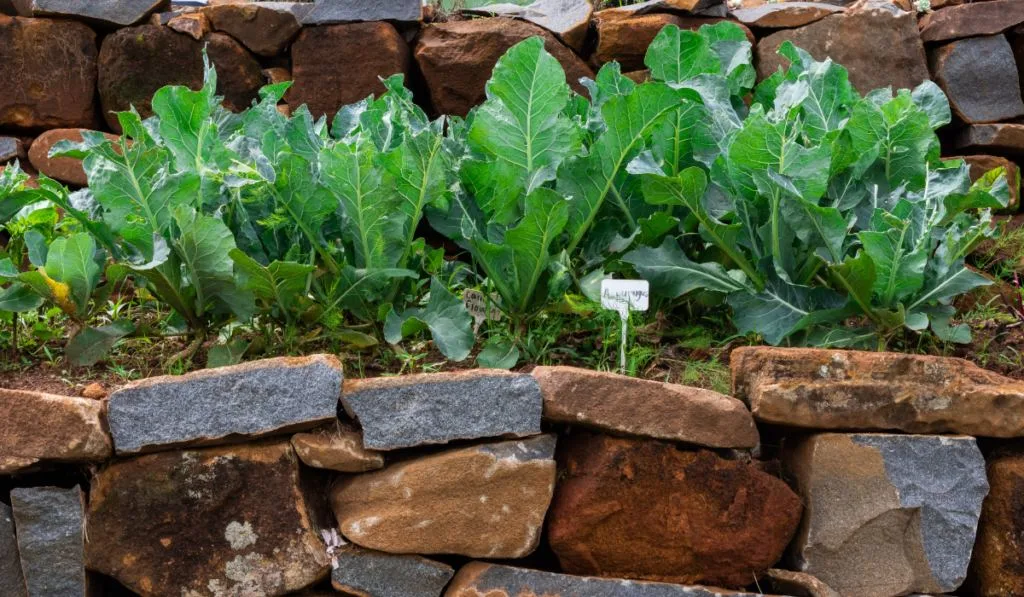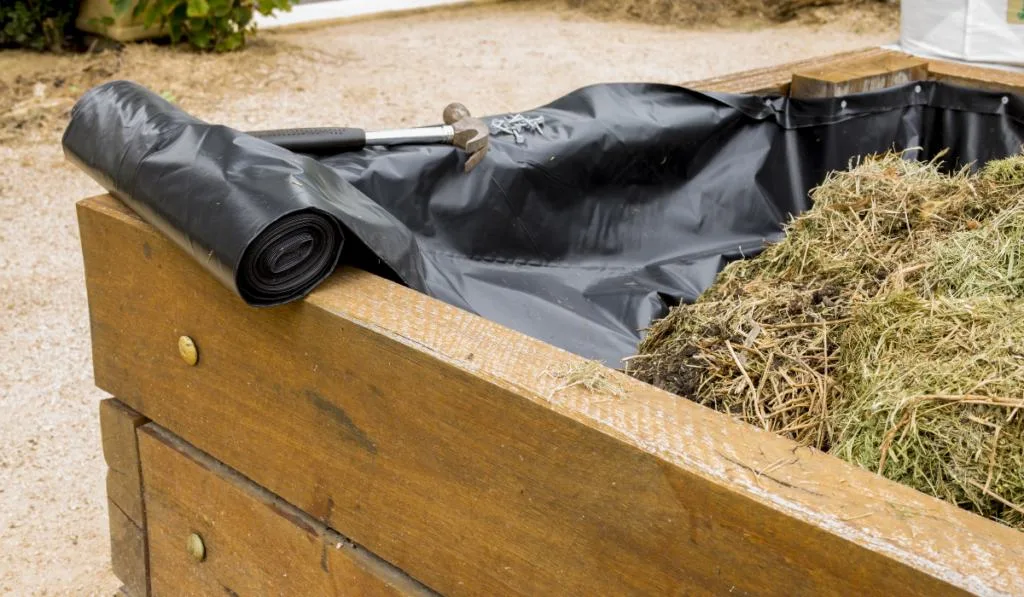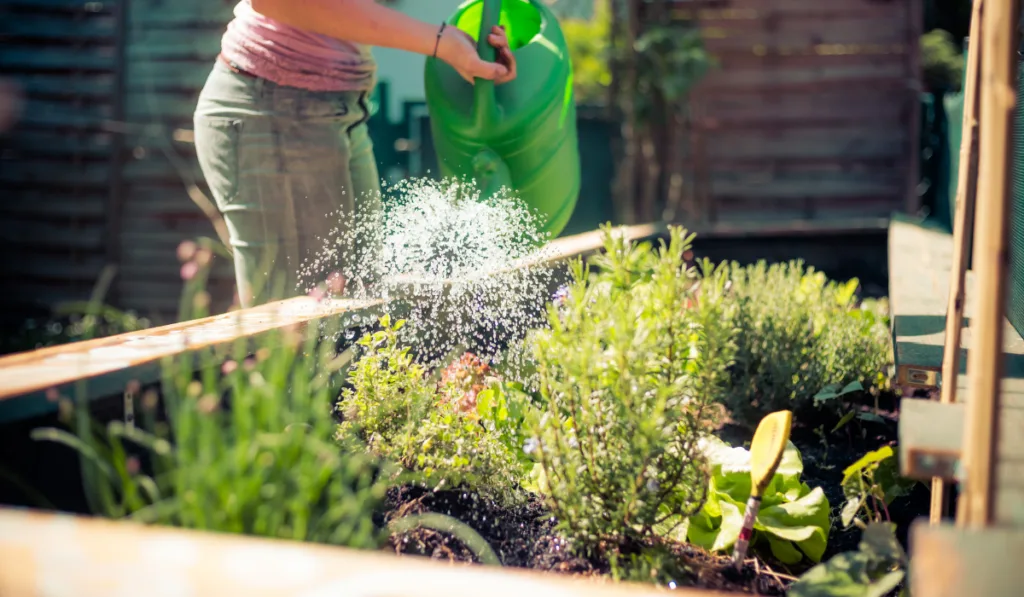Raised garden beds make gardening easier. There are a lot of benefits of raised garden beds. A lot of gardeners are constructing raised garden beds. When thinking about making yours, the first thing to consider is the material you will use as the foundation and frame.

There are a lot of different materials to use for the foundation of your beds, but which ones are the best for you?
Here are some great foundation options for raised garden beds:
Table of Contents
1. Wood
Wood is among the best materials to construct raised garden beds with because it is easy to build, does not have any harmful effects on the plants, and is easy to repair when there are damages. The best types of wood for raised garden beds are redwood and cedarwood.
You can use various types of wood, but make sure that the wood you are using is not coated with any harmful or toxic chemical that can leech into the soil and harm your plants.
2. Composite Lumber

Composite lumber is simply a material that is made from combining wood, plastic, and binding agents. This material is denser than wood alone and does not decay or spoil quickly. It is also more aesthetically pleasing than regular wood.
3. Gabion
Raised garden beds made with gabion may be expensive to build, but they are very beautiful, strong, and durable.
Your plants are safe with a gabion frame and gabion needs less maintenance than other foundation/frame types.
4. Aluminum
Aluminum is great for raised garden beds, but you will need to use liners to prevent it from rusting. Raised beds constructed with aluminum are beautiful and strong.
5. Concrete

Concrete is not left out of the materials to use when constructing raised garden beds. The con about concrete raised beds is that they cannot be moved or easily repaid (if need be).
Before introducing soil into your concrete foundation and frame, make sure that you properly wash it so that it does not increase the pH of the soil.
6. Pallets
Instead of throwing your old pallets away, you can use them to construct raised garden beds. When constructing the raised garden bed, make sure that you block every hole to prevent water loss.
7. Alloy
Alloy is the combination of several materials (of which one or more is metal). While alloy is not the best option for raised beds, it is possible make raised beds from alloy. To prevent rusting and corrosion, you will probably need a liner.
Alloy permits rapid change of temperature of the soil within, so you should install your raised garden bed (made with alloy) in a place with a more stable temperature.
8. Bricks and Blocks
You can use bricks and blocks to make raised garden beds. They are strong and efficient. Bricks and blocks can also help maintain a stable temperature within the raised bed.

9. Plastics
Raised beds made or coated with plastic are beautiful and look unique. Plastics, however, are not so easy to find, so you may not get the exact dimensions you are looking for.
Just like metals, plastics might allow rapid temperature change in your raised bed, so you need to install your plastic raised bed in a place with fewer temperature changes (for example, a corner).
10. Clay Soil
Raised beds made with clay soil are not ideal because their frame will not last more than one planting season. Clay raised beds are very easy to build but are not so durable. One pro is that you can mold the clay into any shape that you want.
11. Stones

Stones are a bit more durable than clay but will need maintenance sooner than other types of raised bed frames. You can arrange your stones into any dimension or shape that you want.
What Else Do Raised Garden Beds Need?
Here are more materials or products that you need to make raised garden beds:
1. Soil
Soil is the most essential part of raised garden beds. You need nutrient-rich and well-aerated soil for your raised garden bed plants to grow strong and healthy.
Make sure you test the soil to make sure there are no pathogens in the soil because soil-borne plant diseases can easily spread in raised garden beds.
2. Lining

Lining or liner is a material used to demarcate the inside of a raised garden bed from the frame or ground below.
- Vertical liners demarcate the soil within the raised garden bed from the frame to prevent the moisture of the soil from spoiling the frame.
- Horizontal liners demarcate soil within the raised garden bed from the soil underneath the raised garden bed to prevent loss of water and also intrusion of underground pests.
Liners are not compulsory to use when making raised garden beds.
3. Mulch
Mulch is great to prevent water loss by evaporation and also acts as a soil amendment when decaying. Examples of materials you can use as mulch are:
- Dry leaves
- Sawdust
- Wood shavings
- Peat moss
- Hay and straw
Mulch is an important part of raised garden beds.
4. Soil Amendment

Soil amendments are products that you can use to correct any issue regarding the quality of soil in your raised garden beds.
Examples of soil amendments are:
- Compost (for nutrients)
- Sand (to increase aeration and water flow rate in the soil)
- Clay (to decrease water flow rate in the soil)
Other examples include peat moss, vermiculite, perlite, etc.
5. Plants
Your raised garden bed is not complete without plants. You can either start your crops directly in the bed or you can transplant them from a nursery.
Later in this article, you will learn the best types of plants to grow in raised garden beds.
Some Uses of Raised Garden Bed Foundations?
Here are cool reasons you should have raised garden beds:
1. Grow Many Plants in a Small Space

Square foot gardening is a practice of cultivating plants in which you divide the area into several square sections (1 foot wide, 1 foot long each). You get to plant what you will grow in each square. Most square foot gardens are done in raised garden beds.
With raised garden beds, you can grow many types of plants in the small area. With proper watering and fertilizing of the plants, you get to harvest much more harvest than other gardeners.
2. Suitable for Various Locations
You do not have to live in the grassland or have access to a large area to grow your favorite crops.
With raised garden beds, you can grow your plants anywhere because raised garden beds are easy to set up and are suitable for just about anywhere (with proper lining).
3. Easier to Control Weeds and Pests
Raised garden beds usually have a lot of plants growing in them, so weeds will not find space to grow and if weeds do grow, the entire bed is usually accessible by hand, so it is easy to pull the weeds.
As for pests, most gardeners who have raised garden beds grow companion plants like lemongrass and others that can repel some types of pests.
4. Best for Tubers and Other Root Vegetable Plants
Did you know that the best way to get more potatoes is by increasing the depth of the soil? This is true for so many tubers.
Raised garden beds are great for rooted vegetables because the vegetables produce more tubers and bulbs and are also easier to harvest.
5. Start the Planting Season Earlier
Raised garden beds get more sunlight and become hot quickly, so you can start your planting season a week or two before other gardeners start their planting season. What’s more? You can nurse plants in raised garden beds before transplanting them to other parts of the garden when you are ready.
How to Care for and Maintain Raised Garden Beds
Here are ways that you can maintain your raised garden beds:
1. Water Plants Regularly

One con about raised garden beds is that water gets lost easily. Unless you are using liners, you will lose a lot of water, especially during the summer.
You should always water your plants so that they do not die of dehydration. Water your plants 2-3 times daily in summer.
2. Pull Weeds Immediately
Weeds can compete with your plants for nutrients in your raised garden bed.
Remember that there is limited space. You want to remove every unwanted plant so that your plants will have sufficient space and nutrients to grow and produce fruits.
3. Use Fertilizer and Soil Amendment Often
You can always add fertilizer and soil amendment to your raised garden bed. You can use either organic or inorganic fertilizer. You can also use compost, rotted manure, etc. as a soil amendment. Fertilizer and soil amendment helps plants to grow strong and healthy.
4. Check for and Fill up Holes and Cracks
If there are holes or cracks in your raised garden bed, water and nutrients will get lost quickly and you do not want that to happen. Make sure that every hole or crack is sealed.
Also, ensure that the roots of your plants are not poking out of the side of your raised garden bed.
5. Practice Crop Rotation
You should not plant the same type of crops in the next growing season. In the next growing season, grow crops in a different family so that diseases that previous crops were susceptible to (and have found their way into the raised garden bed) will not attack the next crops.
If you like, you can have multiple raised garden beds so that you can practice crop rotation easily and more efficiently.
Make sure you take good care of your raised garden bed.
Related Questions and Answers
1. How Deep Should Your Raised Garden Beds Be?
It depends on what you want. Generally, plants are classified into three categories according to their root length:
- Shallow-Rooted Plants (0-12cm): Examples are cabbage, lettuce, sweet corn, onions, radish, etc.
- Mid-Root Plants (12-24 cm): Examples are peas, beans, etc.
- Deep-Root Plants (24-36 cm): Examples are tomato, cucumber, maize, etc.
Plants with roots longer than 36 cm are mostly trees, large shrubs, and other types of plants that are not suitable for raised garden beds.
As you can see, the depth of your raised garden bed is your decision depending on what you want to grow.
2. What Kind of Plants Should You Grow in Raised Garden Beds?
You can grow many types of plants in raised garden beds. Almost every plant including vegetables, flowers, small fruiting plants, etc. can be grown in raised garden beds.
You should, however, not grow trees and other plants that are difficult to uproot.
3. What Are Elevated Garden Beds?
Elevated garden beds are simply garden beds on air. They have legs that raise or elevate them above the surface of the ground. The practice of growing plants in elevating garden beds is similar to growing plants in containers.
Final Thoughts
There are several materials that you can use as a foundation and frame for your raised garden bed. You can also use liners if you like.
Make sure that you enrich your raised garden bed crops with proper fertilizer so that you have success in growing all kinds of plants.
Sources
- https://www.gardeners.com/how-to/materials-for-raised-beds/9578.html
- http://ucmanagedrought.ucdavis.edu/Agriculture/Irrigation_Scheduling/Evapotranspiration_Scheduling_ET/Frequency_of_Irrigation/Crop_Rooting_Depth/
- https://homesteadandchill.com/materials-raised-garden-beds/
- https://www.cleanairgardening.com/5-tips-for-improving-your-raised-bed-garden-soil-2/
- https://dengarden.com/gardening/The-Best-and-Worst-Materials-For-Building-Your-Raised-Up-Garden-Beds
